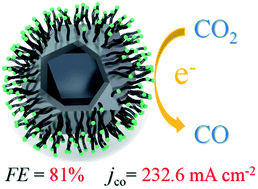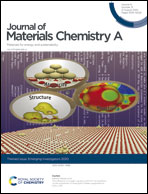In situ encapsulated and well dispersed Co3O4 nanoparticles as efficient and stable electrocatalysts for high-performance CO2 reduction†
Abstract
The development of appropriate catalysts with relatively low cost, good selectivity and excellent stability is one of the major issues in electrochemical reduction of CO2. In this work, an efficient electrocatalyst was fabricated via ultra-small Co3O4 nanoparticles encapsulated within the tip of carbon nanotubes, denoted as Co/CNTs. Benefiting from the synergistic effects of highly active Co3O4 nanoparticles and well-graphitized carbon nanotubes, Co/CNTs exhibited remarkable performance in CO2 electroreduction. In a conventional H-type cell, CO with a 90% faradaic efficiency and 20.6 mA cm−2 partial current density was obtained at only −0.7 VRHE cathode potential with 40 hour stability. Upon switching to a gas-diffusion device, the CO partial current density could reach as high as 232.6 mA cm−2 with >80% faradaic efficiency, which might be even comparable to that of state-of-the-art CO2 electrocatalysts. Our work could also provide a new strategy for developing non-noble metal catalysts for CO2 electroreduction.

- This article is part of the themed collection: Journal of Materials Chemistry A Emerging Investigators


 Please wait while we load your content...
Please wait while we load your content...